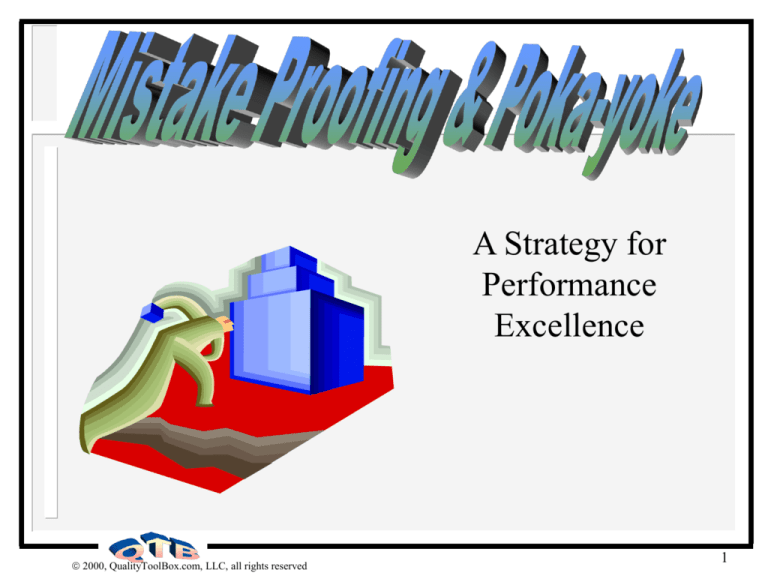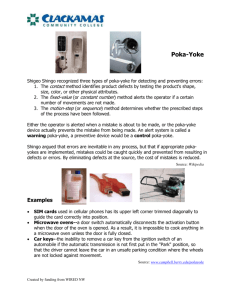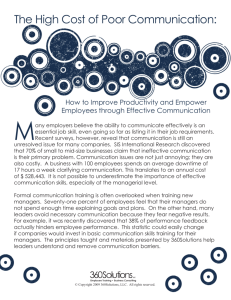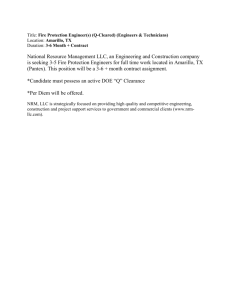
A Strategy for
Performance
Excellence
2000, QualityToolBox.com, LLC, all rights reserved
1
Performance Excellence Series
Training Module Elements
Executive Overview
Lecture notes
Knowledge
Breakthrough
Tools Workbook
Lecture notes
Participant manual
2000, QualityToolBox.com, LLC, all rights reserved
2
Table of Contents
Poka-Yoke ( Mistake Proofing)
Session 1.0
Introduction…….……...…………………….
3
Session 2.0
Zero Defects & Costs………………………..
7
Session 3.0
Waste Management ………………………..
12
Session 4.0
Zero Defect Quality(ZDQ)………………….
19
Session 5.0
Understanding Process Errors…………….
27
Session 6.0
Four Elements of ZDQ……………………..
35
Session 7.0
Seven Steps to Poka-Yoke………………….
42
Session 8.0
Poka-Yoke Methods………………………..
44
Session 9.0
Summary…………………………………….
67
2000, QualityToolBox.com, LLC, all rights reserved
3
Introduction
Defects & Costs
Waste Management
Zero Defect Quality ( ZDQ)
Understanding Process Errors
Four Elements of ZDQ
Seven Steps To Poka-Yoke Attainment
Poka-Yoke Methods
Summary
2000, QualityToolBox.com, LLC, all rights reserved
4
Why is “Zero Defects” an
Important Concept?
Key Element in our capability
to implement Kaizen- Lean
Manufacturing Systems.
No need for “just in case” inventories
Allows company to make only what the
customer needs.
2000, QualityToolBox.com, LLC, all rights reserved
5
6 Sigma
• Data Driven Methodology to Magnify Impact of
Process Improvement
• Apply Control Techniques to Eliminate Erosion of
Improvements
• Proceduralize/Standardize Improvements for
Improved Maintenance of Critical Process Parameters
Process
Improvement
Project
Implemented
Maintenance of
Process
Performance
Time
CPI Project
CPI Projects Emphasize
Control and Long Term
Maintenance
Savings
Kaizen
Time
• Use Small Teams to Optimize Process Performance
by Implementing Incremental Change
• Apply Intellectual Capital of Team Members Intimate
with Process
Kaizen Projects
Emphasize Incremental
Improvements
2000, QualityToolBox.com, LLC, all rights reserved
Kaizen
Savings
Savings
Why Kaizen
CPI
Time
6
Tool Kit Comparison
Major
Tools
CPI
(6s)
Kaizen Lean
Cp/Cpk
4
DOE
4
SPC
4
FMEA
4
Regression
4
Process Map
4
4
5 whys /2 hows 4
methods for root cause discovery
Pareto
4
4
Fishbone
4
4
5S
4
Visual Mgmt
4
4
Poka-Yoke
4
Spaghetti Chart
4
Kanban
4
Takt Time
4
Std Work
4
SMED
4
TPM
4
Cellular Flow
4
4
4
4
Description
Process capability assessment
Design of experiments
Process control based on statistics and data analysis
Risk assessment tool
Correlate effect one variable has on another
Map process steps to communicate and identify opportunities
4
4
Determination
Column chart ranking items highest to lowest
4
Cause / Effect Diagram
Elimination waste
4
Emphasis on visual techniques to manage process
4
Error proofing techniques
4
Material storage technique used to control process
Determine pace or beat of a process
Evaluate tasks done during a process
Single minute exchange of dies - Quick machine set up
Integrate maintenance strategy with process
Reduce inventory & cycle time through process layout and pull
production techniques
4
4
4
4
4
4
Expand Process Improvement Program to Utilize Kaizen Tool Kit
2000, QualityToolBox.com, LLC, all rights reserved
7
Introduction
Defects & Costs
Waste Management
Zero Defect Quality ( ZDQ)
Understanding Process Errors
Four Elements of ZDQ
Seven Steps to Poka-Yoke Attainment
Poka-Yoke Methods
Summary
2000, QualityToolBox.com, LLC, all rights reserved
8
Why is “Zero Defects” an Important
Concept?
Maintain Customer Satisfaction & Loyalty
Happy Customers mean more sales!
2000, QualityToolBox.com, LLC, all rights reserved
9
Why is “Zero Defects” an Important
Concept?
COST
There is always a cost
associated with
manufacturing defects!
2000, QualityToolBox.com, LLC, all rights reserved
10
Costs of Defects ?
Does it cost more to make processes better ?
NO
Making processes better leads to reduced
Rework
Scrap
Warranty costs
Inspection costs
2000, QualityToolBox.com, LLC, all rights reserved
11
1-10-100 Rule
The 1-10-100 rule states that as a product or service moves through
the production system, the cost of correcting An error multiplies by
10.
Activity
Cost
Order entered correctly
$1
Error detected in billing
$ 10
Error detected by customer
$ 100
Dissatisfied customer shares the experience with others the costs is
$1000
2000, QualityToolBox.com, LLC, all rights reserved
12
Introduction
Defects & Costs
Waste Management
Zero Defect Quality ( ZDQ)
Understanding Process Errors
Four Elements of ZDQ
Seven Steps to Poka-Yoke Attainment
Poka-Yoke Methods
Summary
2000, QualityToolBox.com, LLC, all rights reserved
13
Why is “Zero Defects” an
Important Concept?
Key Element in our capability
to eliminate waste.
Defects
Misused resources
Inventories
Untapped Resources
Motions
Delays
Processes
2000, QualityToolBox.com, LLC, all rights reserved
14
What is Waste?
Everything we do that
costs something without
adding value to the product
Our objective > Value added = Maximum
Non-Value Added = Minimum
2000, QualityToolBox.com, LLC, all rights reserved
15
The nine types of waste
9
Wastes
Overproduction
Delays (waiting time)
Transportation
Process
Inventories
Motions
Defective products
Untapped resources
Misused resources
2000, QualityToolBox.com, LLC, all rights reserved
16
Continuous Improvement
Is the continuous
elimination of waste
2000, QualityToolBox.com, LLC, all rights reserved
17
Elimination of Waste
The Method
Identify
waste
Check and
measure
results
Search for
causes
Implement
continuous
improvement
2000, QualityToolBox.com, LLC, all rights reserved
18
Elimination of Wastes and Continuous
Improvement
The Approach
Elimination of
wastes
The Means
KAIZEN
Continuous
Improvement
2000, QualityToolBox.com, LLC, all rights reserved
One piece flow
SMED
Visual Controls
Workplace
Organization
Kanban
Standard Work
Process Control
Total Productive
Maintenance
Poka-Yoke
The Strategy
•Leadtime
•Costs
Quality
the
First Time
19
Introduction
Defects & Costs
Waste Management
Zero Defect Quality ( ZDQ)
Understanding Process Errors
Four Elements of ZDQ
Seven Steps to Poka-Yoke Attainment
Poka-Yoke Methods
Summary
2000, QualityToolBox.com, LLC, all rights reserved
20
What is a Zero Defect Quality
System (ZDQ)?
A quality concept to manufacture ZERO defects
& elimination of waste associated with defects!
“ZERO” is the goal!
2000, QualityToolBox.com, LLC, all rights reserved
21
What is a Zero Defect Quality
System (ZDQ)?
Based on a discipline that
defects are prevented.
Control the process so that defects
are impossible!
2000, QualityToolBox.com, LLC, all rights reserved
22
What is a Zero Defect Quality
System (ZDQ)?
No Finger Pointing.
Operators and Machines
will sometimes make
mistakes.
Find ways to keep errors from
becoming defects!
2000, QualityToolBox.com, LLC, all rights reserved
23
What is a Zero Defect Quality
System (ZDQ)?
A Method for MistakeProofing (Poka-yoke) a
process.
ZDQ assures that defects are not
shipped!
2000, QualityToolBox.com, LLC, all rights reserved
24
How ZDQ Makes Work Easier
Mistake-Proof or Poka-yoke the process!
Recognize that it is natural
for people to make
mistakes.
2000, QualityToolBox.com, LLC, all rights reserved
25
How ZDQ Makes Work Easier
Mistake-Proof or Poka-yoke the process!
Not noticing that an error is
made or a machine is not
functioning does not make a
person stupid or foolish.
2000, QualityToolBox.com, LLC, all rights reserved
26
How Do We Achieve ZDQ ?
Mistake-Proof or Poka-yoke the process!
Errors never become defects!
No finger pointing after the
fact. No mandate to do
better next time.
2000, QualityToolBox.com, LLC, all rights reserved
27
Introduction
Defects & Costs
Waste Management
Zero Defect Quality ( ZDQ)
Understanding Process Errors
Four Elements of ZDQ
Seven Steps to Poka-Yoke Attainment
Poka-Yoke Methods
Summary
2000, QualityToolBox.com, LLC, all rights reserved
28
Poka-Yoke results in Quality of Processes
Quality the 1st time
Cost
Leadtime
Transformation = Quality production the 1st time
Inspection….eliminated ???
Transport
Dedicated lines
Storage
Delay/wait
2000, QualityToolBox.com, LLC, all rights reserved
One piece flow
29
Relationship between processes and quality defects.
•Almost any business activity can be considered a process.
•Production processes involve the flow of material. Machining,
assembly, and packaging are typical production processes.
•Business processes involve the flow of information. Financial
planning, purchasing & order entry are typical business
processes.
•All processes have the potential for defects. Hence, all processes
offer a opportunity for the elimination of defects and the resultant
quality improvement.
2000, QualityToolBox.com, LLC, all rights reserved
30
In order to reduce quality defects and stop
throwing away money, we must
=
Understand the process an its relationship to other business processes.
Identify the inputs and outputs of the process.
Know who are the suppliers to and customers of the process.
And
Reduce the
variation of the process
2000, QualityToolBox.com, LLC, all rights reserved
31
What Causes Defects?
Process Variation From
1. Poor procedures or standards.
2. Machines.
3. Non-conforming material.
4. Worn tooling.
5. Human Mistakes.
Except for human mistakes these conditions can be predicted
and corrective action can be implemented to eliminate the
cause of defects
2000, QualityToolBox.com, LLC, all rights reserved
32
What Causes Defects?
Human Mistakes
Simple errors-the most common cause of defects-occur unpredictably.
The goal of ZDQ is zero! Make certain that the
required conditions are in place and controlled
to make acceptable product 100% of the time.
2000, QualityToolBox.com, LLC, all rights reserved
33
Ten Types of Human Mistakes
Forgetfulness
Misunderstanding
Wrong identification
Lack of experience
Willful (ignoring rules or procedure)
Inadvertent or sloppiness
Slowliness
Lack of standardization
Surprise (unexpected machine operation, etc.)
Intentional (sabotage)
2000, QualityToolBox.com, LLC, all rights reserved
34
2000, QualityToolBox.com, LLC, all rights reserved
35
Introduction
Defects & Costs
Waste Management
Zero Defect Quality ( ZDQ)
Understanding Process Errors
Four Elements of ZDQ
Seven Steps to Poka-Yoke Attainment
Poka-Yoke Methods
Summary
2000, QualityToolBox.com, LLC, all rights reserved
36
The 4 Components of ZDQ
ZDQ functions by combining four elementary components:
1. Point of Origin Inspection
2. 100 % Audit Checks
3. Immediate Feedback
4. Poka-Yoke
2000, QualityToolBox.com, LLC, all rights reserved
37
Inspection
The 3 basic approaches to inspection of processed product are:
Judgement/Standard Inspection
Informative Inspection
Point of Origin Inspection
The first two approaches are widely used and considered
traditional.
Only Point of Origin Inspection actually eliminates
defects.
2000, QualityToolBox.com, LLC, all rights reserved
38
Point of Origin Inspection
Focus on prevention, not detection.
One of the 4 basic elements of ZDQ.
May include: Switches that detect miss-fed
parts
Differs from Judgement and Informative:
Pins that prevent miss-feeding
Warning lights
Catches errors
Sound signals
Gives feedback before processing
No risk of making more defective product
Process with Zero Defects
By combining Check and Do in the
ZDQ approach; the Doing is controlled
so it cannot be wrong 100% of the time!
2000, QualityToolBox.com, LLC, all rights reserved
Detect Error
Feedback/Corrective Action
39
ZDQ/Check and Do/Point of Origin
Inspection
Point of Origin Inspection
•Check for optimum process conditions
before processing is done and errors can be
made.
•Instant feedback.
•Corrections made before defects occur.
2000, QualityToolBox.com, LLC, all rights reserved
40
100% Audit Checks
Point of Origin Inspection on every piece.
The second of the 4 basic elements of ZDQ.
Differs from SQC inspection:
Zero Defects
Does not rely on sampling
Prevents defects
Does not assume defects will statistically occur
100% Audit checks everything on the line!
2000, QualityToolBox.com, LLC, all rights reserved
41
Quick Feedback
Error correction as soon as possible
The third of the 4 basic elements of ZDQ.
Differs from traditional inspection approaches that:
Correct problems after the process
Address the problem when errors are already defects
In some cases never identify an error has occurred
ZDQ sends the operator a signal and alarms
the person that an error has happened!
ZDQ Inspections = Immediate Feedback
2000, QualityToolBox.com, LLC, all rights reserved
42
Introduction
Defects & Costs
Waste Management
Zero Defect Quality ( ZDQ)
Understanding Process Errors
Four Elements of ZDQ
Seven Steps to Poka-Yoke Attainment
Poka-Yoke Methods
Summary
2000, QualityToolBox.com, LLC, all rights reserved
43
The Seven Guidelines to Poka- Yoke Attainment
1.) Quality Processes - Design “Robust” quality processes to achieve zero defects.
2.) Utilize a Team Environment- leverage the teams knowledge,experience to
enhance the improvement efforts.
3.) Elimination of Errors -Utilize a robust problem solving methodology to drive
defects towards zero.
4.) Eliminate the “Root Cause” of The Errors-Use the 5 Why’s and 2 H’s approach
5.) Do It Right The First Time- Utilizing resources to perform functions correctly the
“first” time.
6.) Eliminate Non-Value Added Decisions- Don’t make excuses-just do it !
7.) Implement an Incremental Continual Improvement Approach-implement
improvement actions immediately and focus on incremental improvements; efforts do
not have to result in a 100% improvement immediately.
2000, QualityToolBox.com, LLC, all rights reserved
44
Introduction
Defects & Costs
Waste Management
Zero Defect Quality ( ZDQ)
Understanding Process Errors
Four Elements of ZDQ
Seven Steps to Poka-Yoke Attainment
Poka-Yoke Methods
Summary
2000, QualityToolBox.com, LLC, all rights reserved
45
Poka-yoke
Mistake-proofing systems
The fourth of the 4 basic elements of ZDQ.
“The machine shut
down. We must have
made an error!”
Does not rely on operators catching mistakes
Inexpensive Point of Origin inspection
Quick feedback 100% of the time
BEEP!
BEEP!
Most Poka-yoke devices are sensor or jig devices
that assure 100% compliance all the time!
2000, QualityToolBox.com, LLC, all rights reserved
BEEP!
46
Poka-yoke
What is Poke-yoke?
A method that uses sensor or other devices for catching
errors that may pass by operators or assemblers.
Poka-yoke effects two key elements of ZDQ:
Identifying the defect immediately ( Point of Origin Inspection)
Quick Feedback for Corrective Action
How effective the system is depends on where it is used: Point of Origin or
Informative Inspection.
Poka-yoke detects an error, gives a
warning, and can shuts down the
process.
2000, QualityToolBox.com, LLC, all rights reserved
47
Poka-yoke
Poke-yoke and Point of Origin Inspections( Proactive Approach):
A fully implemented ZDQ system requires Poka-yoke
usage at or before the inspection points during the
process.
Poka-yoke will catch the errors
before a defective part is
manufactured 100% of the time.
2000, QualityToolBox.com, LLC, all rights reserved
48
Poka-yoke
Poka-yoke and Informative Inspection( Reactive Approach):
•Check occurs immediately after the process.
•Can be an operator check at the process or successive check at the next
process.
•Not 100% effective, will not eliminate all defects.
•Effective in preventing defects from being passed to next process.
Although not as effective as the Source
inspection approach, this methodology is
more effective than statistical sampling
and does provide feedback in reducing
defects.
2000, QualityToolBox.com, LLC, all rights reserved
49
Poka-yoke Systems Govern the Process
Two Poka-Yoke System approaches are utilized in
manufacturing which lead to successful ZDQ:
1. Control Approach
Shuts down the process when an error
occurs.
Keeps the “suspect” part in place when
an operation is incomplete.
2. Warning Approach
Signals the operator to stop the process
and correct the problem.
2000, QualityToolBox.com, LLC, all rights reserved
50
Control System
Takes human element out of the equation;does not
depend on an operator or assembler.
Has a high capability of achieving zero defects.
Machine stops when an irregularity is detected.
2000, QualityToolBox.com, LLC, all rights reserved
“There must have been
an error detected; the
machine shut down by
itself!”
51
Warning System
Sometimes an automatic shut off system is not an option.
A warning or alarm system can be used to get an operators
attention.
Below left is an example of an alarm system using dials, lights and
sounds to bring attention to the problem.
Color coding is also an effective non automatic option.
BEEP!
“I’m glad the alarm
went off, now I’m
not making defects!”
BEEP!
BEEP!
2000, QualityToolBox.com, LLC, all rights reserved
52
Methods for Using Poka-yoke
Poka-yoke systems consist of three
primary methods:
1. Contact
2. Counting
3. Motion-Sequence
Each method can be used in a control
system or a warning system.
Each method uses a different process
prevention approach for dealing with
irregularities.
2000, QualityToolBox.com, LLC, all rights reserved
53
Contact Method
A contact method functions by detecting whether a sensing
device makes contact with a part or object within the process.
Cylinder present
Missing cylinder;piston fully
extended alarm sounds
An example of a physical contact
method is limit switches that are
pressed when cylinders are driven into
a piston. The switches are connected
to pistons that hold the part in place.
In this example, a cylinder is missing
and the part is not released to the next
process.
Cannot proceed
to next step.
Contact Method using limit
switches identifies missing
cylinder.
2000, QualityToolBox.com, LLC, all rights reserved
54
Physical Contact Devices
Toggle Switches
Limit Switches
2000, QualityToolBox.com, LLC, all rights reserved
55
Energy Contact Devices
Photoelectric switches can
be used with objects that
are translucent or
transparent depending upon
the need.
Light
Transmitter
Receiver
Object
Transmission method: two units,
one to transmit light, the other
to receive.
Reflecting method:PE sensor
responds to light reflected from
object to detect presence.
If object breaks the transmission, the machine is signaled to shut down.
2000, QualityToolBox.com, LLC, all rights reserved
56
Contact Device
An example of a
contact device using a
limit switch. In this
case the switch makes
contact with a metal
barb sensing it’s
presence. If no
contact is made the
process will shut
down.
2000, QualityToolBox.com, LLC, all rights reserved
57
Contact Methods
Do not have to be high tech!
Passive devices are sometimes the best method. These can be as
simple as guide pins or blocks that do not allow parts to be seated
in the wrong position prior to processing
Take advantage of parts designed with an uneven shape!
A work piece with a hole a bump or an uneven end is a perfect candidate for
a passive jig. This method signals to the operator right away that the part is
not in proper position.
2000, QualityToolBox.com, LLC, all rights reserved
58
Counting Method
Used when a fixed number of operations are required within a process, or
when a product has a fixed number of parts that are attached to it.
A sensor counts the number of times a part is used or a process is completed
and releases the part only when the right count is reached.
In the example to the right a limit switch is
used to detect and count when the required
amount of holes are drilled. The buzzer
sounds alerting the operator that the
appropriate amount of steps have been taken
in the process.
2000, QualityToolBox.com, LLC, all rights reserved
59
Counting Method
Another approach is to count the number of parts or components required
to complete an operation in advance. If operators finds parts leftover using
this method, they will know that something has been omitted from the
process.
“I have an extra
part. I must have
omitted a step!”
2000, QualityToolBox.com, LLC, all rights reserved
60
Motion-Sequence Method
The third poka-yoke method uses sensors to determine if a motion or a step
in a process has occurred. If the step has not occurred or has occurred out of
sequence, the the sensor signals a timer or other device to stop the machine
and signal the operator.
This method uses sensors and photo-electric
devices connected to a timer. If movement does
not occur when required, the switch signals to
stop the process or warn the operator.
2000, QualityToolBox.com, LLC, all rights reserved
61
Motion-Sequence Method
In order to help operators select the right parts for the right step in a process
the “sequencing” aspect of the motion-step method is used. This is especially
helpful when using multiple parts that are similar in size and shape.
In this example, each step of the machine cycle is wired to an indicator board
and a timer. If each cycle of the machine is not performed within the required
“time” and “sequence”, the indicator light for that step will be turned on and
the machine will stop.
Machine
2000, QualityToolBox.com, LLC, all rights reserved
Indicator Board
62
Types of Sensing Devices
Sensing devices that are traditionally used in poka-yoke
systems can be divided into three categories:
1. Physical contact devices
2. Energy sensing devices
3. Warning Sensors
Each category of sensors includes a broad range
of devices that can be used depending on the
process.
2000, QualityToolBox.com, LLC, all rights reserved
63
Physical Contact Sensors
These devices work by
physically touching
something. This can be a
machine part or an actual
piece being manufactured.
In most cases these
devices send an electronic
signal when they are
touched. Depending on
the process, this signal can
shut down the operation or
give an operator a warning
signal.
2000, QualityToolBox.com, LLC, all rights reserved
64
Touch Switch
Used to physically detect the presence or absence of an
object or item-prevents missing parts.
Used to physically detect the height of a part or
dimension.
2000, QualityToolBox.com, LLC, all rights reserved
65
Energy Sensors
These devices work by
using energy to detect
whether or not an defect
has occurred.
Fiber optic
Vibration
Photoelectric
2000, QualityToolBox.com, LLC, all rights reserved
66
Warning Sensors
Warning sensors signal the
operator that there is a
problem. These sensors use
colors, alarms, lights to get
the workers attention !
Color Code
These sensors may be used in
conjunction with a contact or
energy sensor to get the
operators attention.
Lights
2000, QualityToolBox.com, LLC, all rights reserved
Lights connected
to Micro switches
& timers
67
Introduction
Defects & Costs
Waste Management
Zero Defect Quality ( ZDQ)
Understanding Process Errors
Four Elements of ZDQ
Seven Steps to Poka-Yoke Attainment
Poka-Yoke Methods
Summary
2000, QualityToolBox.com, LLC, all rights reserved
68
To prevent mistakes, develop error proofing devices
POKA-YOKE
to avoid (yokeru) inadvertent errors (poka)
Checklists
Dowel and locating pins
Error & alarm detectors
Limit or touch switches
Detectors, readers, meters, counters
2000, QualityToolBox.com, LLC, all rights reserved
69
Two types of error proofing devices
POKA-YOKE
Control - eliminates the possibility of a
mistake to occur (automatic machine
shutdown)
Warning - signals that a mistake can occur
(blinking light, alarm, etc.)
2000, QualityToolBox.com, LLC, all rights reserved
70
3 Rules of POKA-YOKE
Don’t wait for the perfect POKAYOKE. Do it now!
If your POKA-YOKE idea has
better than 50% chance to
succeed…Do it!
Do it now….improve later!
2000, QualityToolBox.com, LLC, all rights reserved
71
Some examples of POKA-YOKE devices
Attached gas cap
Gas pump nozzle
Polarized electrical plug and socket
Disc brake pad warning noise
2000, QualityToolBox.com, LLC, all rights reserved
72
Source Inspection
Detects mistakes before they become defects
Transformation = Quality production the 1st time
Inspection….eliminated ???
Transport
Dedicated lines
Storage
Delay/wait
2000, QualityToolBox.com, LLC, all rights reserved
One piece flow
73



![Your_Solutions_LLC_-_New_Business3[1]](http://s2.studylib.net/store/data/005544494_1-444a738d95c4d66d28ef7ef4e25c86f0-300x300.png)


